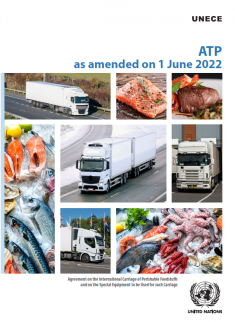
The Agreement on the International Carriage of Perishable Foodstuffs and on the Special Equipment to be Used for such Carriage (ATP) was done at Geneva on 1 September 1970 and entered into force on 21 November 1976.
The objectives of the ATP are to facilitate international transport of perishable foodstuffs and to ensure a high level of preservation of the quality of perishable foodstuffs during their carriage.
The ATP applies to the carriage of perishable foodstuffs performed on the territory of at least two Contracting States not only by road, but also by rail and by sea (sea crossings must be less than 150 km long). In addition, a number of countries have also adopted the ATP as the basis for their national legislation.
The ATP establishes harmonized and improved technical conditions for the preservation of the quality of perishable foodstuffs during their carriage. These conditions concern mainly the temperature to be observed during the carriage and the equipment used for the carriage. The ATP establishes the appropriate temperatures under which the various types of perishable foodstuffs should be carried. It also lays down the requirements for the equipment, including its refrigerating capacity, insulating capacity and efficiency of thermal appliances as well as the methods and procedures for measuring and checking them.
The equipment to be used for transport according to ATP must be certified by a Contracting Party according to the results of tests, the methodology of which is also contained in the ATP. The Contracting Party issues a certificate of compliance with the ATP standards, which is recognized by all the other Contracting Parties to the ATP.
The ATP is an Agreement between States, and there is no overall enforcing authority. In practice, highway checks are carried out by Contracting Parties, and non-compliance may then result in legal action by national authorities against offenders in accordance with their domestic legislation. ATP itself does not prescribe any penalties.
In addition to the text of the ATP Agreement, the publication has three Annexes: Annex 1 – Definitions of and standards for special equipment for the carriage of perishable foodstuffs; Annex 2 – Selection of equipment and temperature conditions to be observed for the carriage of quick (deep)-frozen and frozen foodstuffs; and Annex 3 – Temperature conditions for the carriage of certain foodstuffs which are neither quick (deep)-frozen nor frozen.
For more information, including the latest updates to the Agreement and access to the ATP Agreement and ATP Handbook in electronic format, visit the ATP and ATP Handbook sections of the UNECE Sustainable Transport Division Website.

